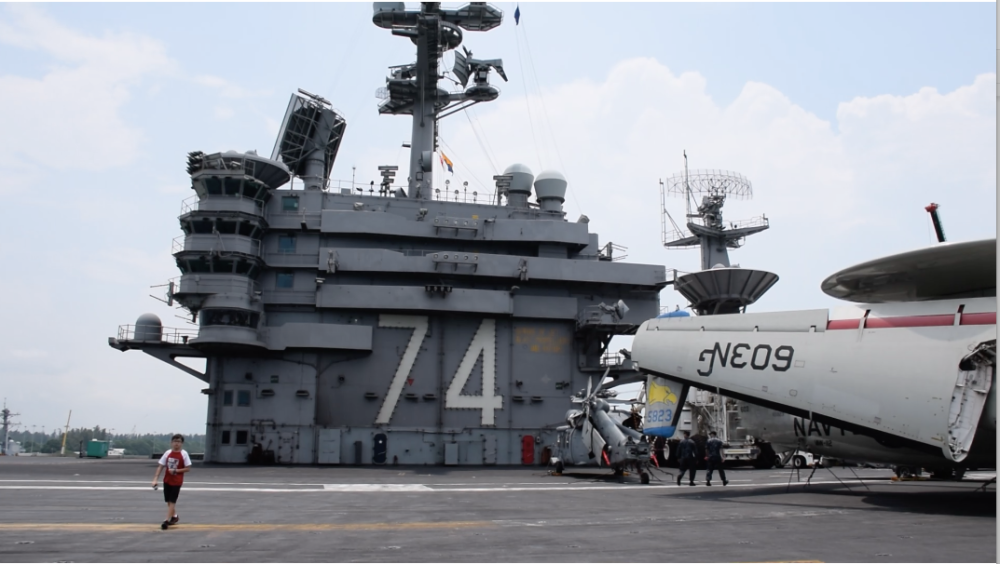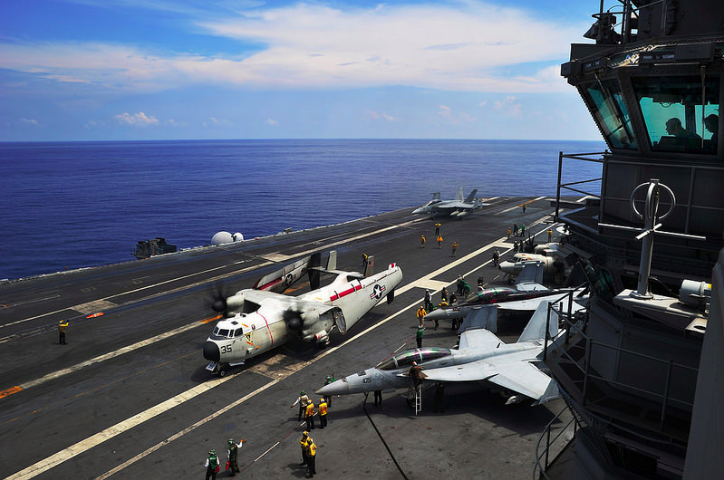The U.S. Navy’s “Great Green Fleet” docked at the Singapore Changi Naval Base on April 19 for a regular port visit. Shortly after, the USS John C Stennis was denied a Hong Kong visit request by China. The South China sea is at the center of tensions between China, Malaysia, Taiwan, Vietnam, and the Philippines, who are all disputing sovereignty of several island chains and nearby waters. All of this poses a threat to the safety of the South China Sea.

While ported in Singapore, the sailors participated in some activities around Singapore, such as a community service project at Willing Hearts Soup Kitchen in Chai Chee. The John C. Stennis, one of America’s 19 Aircraft Carriers, also offered tours of the ship to the Singapore navy, as well as China News Asia.

View of the top of USS John C Stennis. The 74 shows that the ship is the 74th Cruiser Voler Nuclear(CVN) created in the U.S navy, but many carriers have been decommissioned, which is why there are currently only 19 carriers operational. Photo by Alyssa Renert
After leaving Singapore on April 22, USS John C. Stennis continued its mission of patrolling the South China Sea, where it was denied port access in Hong Kong. The United States has been sending patrol fleets such as the “Great Green Fleet” to monitor the actions of the countries in the surrounding area, especially China, as Beijing is building and militarising man-made islands in the area to strengthen its claims.
“We have Chinese ships around us that we normally didn’t see in my past experience,” Capt. Greg Huffman, Stennis’ commanding officer, said in the Navy release in early March. (CNN Article)
Why is the U.S getting involved in the conflicts of the South China Sea? ASEAN members who have the most at stake in the South China Sea – principally Vietnam, the Philippines, and Malaysia – have a regional organization that has little ability to stand up to China. As a result, these countries are increasingly looking to other outside powers such as the U.S for aid.
Senior Vivian Nemenyi comments, “I don’t think that the U.S should be involved because it’s not really their issue. It mostly concerns the Asian countries, it doesn’t concern the U.S.”
President Barack Obama and Secretary Ash Carter have stated that the United States will fly, sail and operate anywhere international law allows. That is true in the South China Sea, as in other places around the globe.
Through the U.S.’s growing presence in the South China Sea, the U.S. is gaining more Asian military alliances. The U.S. is trying to be more focused on the conflict in the Sea than in the Middle East. According to an article from the council on foreign relations, “the United States has rebuilt traditional alliances with the Philippines, continued the increasingly close relationship with Vietnam, built a de facto alliance with Singapore, and even wooed Cambodia and Myanmar, countries long alienated from the United States.”
“I feel like this issue is something that should be taken by an international body like the UN (United Nations), because I feel like the U.S could be seen as imperialistic in this case,” said sophomore Shyla Bector, who recently chaired in a middle school Model UN conference in Malaysia.

Singapore, because it has no territorial claims in the area, acts as a neutral party and can communicate between the disputing countries. Singapore has also suggested expanding a concept called the Code for Unplanned Encounters at Sea (CUES) to the involved parties to avoid accidental miscalculations that can lead to conflict at sea. These disputes have effects on peace and stability, freedom of navigation and overflight, as well as trading in Singapore, which are all valuable to the city-state.
It is hard to say whether this conflict will impact the U.S and the Southeast Asian countries in a positive or negative way. However ,in the worst case scenario of war, the U.S’s great green fleet and the USS John C Stennis will be there to help protect those nations who cannot protect themselves.